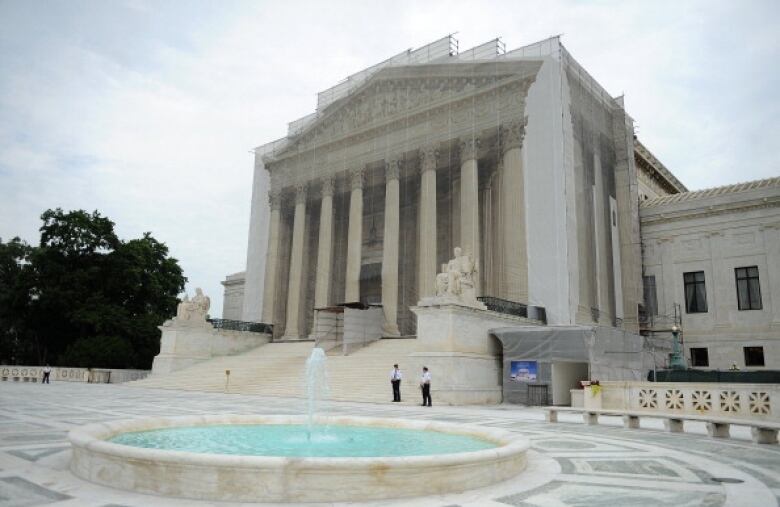The big cover-up: Centre Block to be draped with 'trompe l'oeil' wrap during work
Will preserve building's historic facade as restoration continues

The federal government will soon drape Centre Block with a trompe l'oeilcovering that will replicate the visage of the historic Parliament Hill building during its ongoing rehabilitation.
Work to install the $3.9-million covering will begin later this spring, starting with the north side,according to Public Services and Procurement Canada (PSPC).
French for "deceive the eye,"trompe l'oeilrefers to an artistic technique that attempts to mimic three dimensions on a two-dimensional surface.
The idea of shroudingCentre Block with a largetrompe l'oeiltarp a method of obscuring construction work that's popular in Europe has been around since at least 2016, when it was pitched by Ottawa Tourism as a way of maintaining the Peace Tower'slook during the decade-long rehabilitation efforts.
At the time, there were concerns about the price, withthe National Capital Commission noting such coverings can cost hundreds of thousands of dollars.
Ottawa Tourismissued a similar callin 2018, hoping topreservethe Peace Tower'sInstagrammable"money shot"for future visitors to the nation's capital.
Keeping some semblance of the "crucial icon" will mean a lot to many of Ottawa's roughly 11 million annual visitors, saidCatherine Callary, the vice-president of destination development with the local tourism agency.
"It represents Canadian democracy. It's the backdrop for many of the protests and the demonstrations that take place on the front lawn. It is where big decisions are made for the whole country," Callary told CBC News last week.
"[Tourists] can't just come back another time or next week. This is when they're here. This is when they'd like to see what is probably Ottawa's most photographed site."

Tarps needed anyways, says PSPC
According to PSPC spokesperson Michle Larose, the federal government is spending $1.5 million for thewrapping, plus an additional $2.4 million to convert it into a trompe l'oeil.
The tarpwill be installed first on Centre Block's north facade, facing the Ottawa River, before extending around the sides and the south facade on Parliament Hill over the course of the rehabilitation work, Larosesaid in a statement.
The images being used arebased on actual photographs of Centre Block. The handson the Peace Tower's clock will be set to 11:45, which represents the timethe tower and its carillon were inaugurated in 1927, she said.
Tarps would have been required regardless, Larosenoted, inorder to create a "climate-controlled and safe environment" for the work, the "largest and most complex rehabilitation projectin Canada's history."
-
Dominion Carillonneur ready to play one last chime before Peace Tower renovation
- Major overhaul in store for entire block facing Parliament
The decade-long endeavour to overhaul Centre Block which houses the House of Commons, the Senate chambers, the Library of Parliament and MP's officesinvolves upgrading thebuildings' seismic resilience, systems and security, while also making them more energy-efficient and accessible.
The federal government is also buildinga new welcome centre to handle the tens of thousands of tourists that visit Parliament Hill each year.

As for the project's progress: the masonry work on the north side is roughly one-quarter done, Larose said, while more than seven million kilograms of asbestos-containing material have been removed from the site's interior.
The excavation work for the welcome centre is roughly 65 per cent complete, she added, with at least 27,000 truckloads of rock hauled away.
At the moment, PSPCsaid ithas no plans to install similar coverings on any other buildings.












_(720p).jpg)


 OFFICIAL HD MUSIC VIDEO.jpg)
.jpg)



























































































